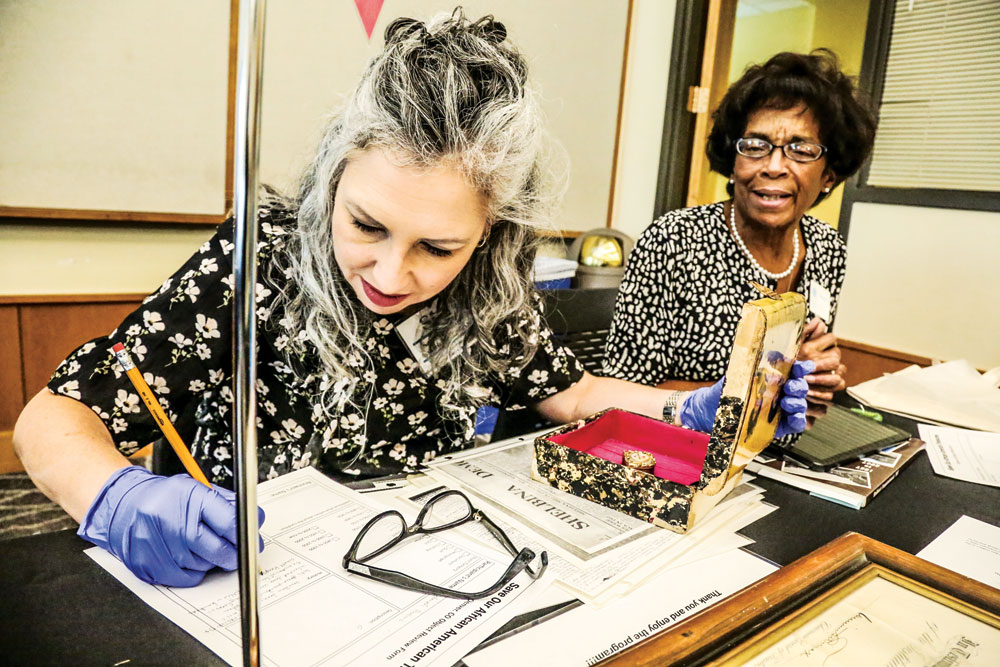
Smithsonian curator Nora Lockshin examines Deborah Parson’s family heirlooms.
For more than 150 years before we became a country, and for almost 100 years after our independence, the country prospered on the backs of enslaved people. The unpaid labor performed by African Americans from 1776 to 1865 has been valued from $5.9 to $14.2 trillion by University of Connecticut researcher Thomas Craemer, PhD. Now—as an African American woman is being recognized as a top-tier presidential candidate—the country is long overdue in recognizing the contributions of African Americans that form a rich and robust thread woven thickly throughout the American tapestry. Denver’s Blair-Caldwell African American Research Library and the Black American West Museum partnered with the National Museum of African American History and Culture to explore the stories of local African American families through their family heirlooms.
A Much-Loved Keepsake Box
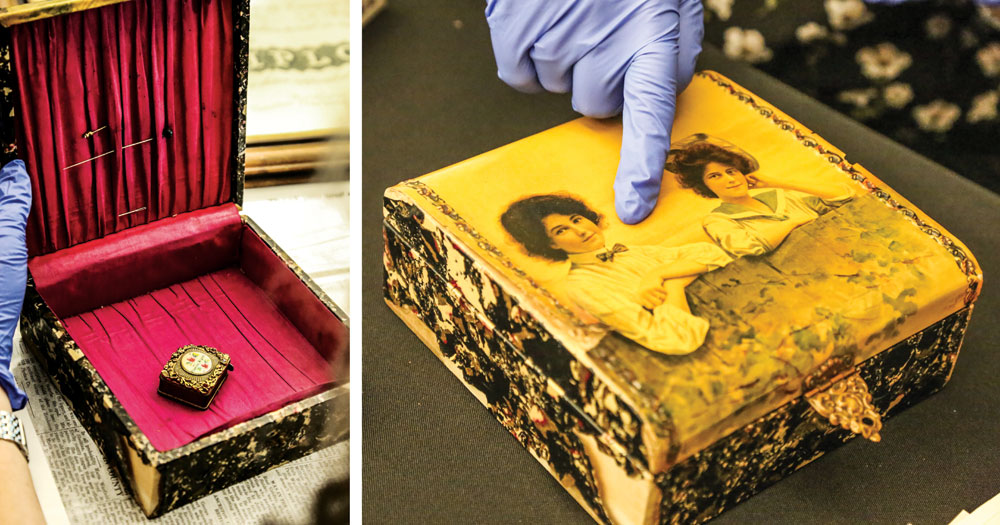
Deborah Parson’s family heirlooms.
Since her retirement, Deborah Parsons has spent much of her time listening to other people’s stories as a volunteer archivist at the Blair-Caldwell African American Research Library. She traveled with the African American Museum of History and Culture to South Carolina where she not only learned about heritage, lineage, and culture but also received certificates from both the African American Museum’s Preservation Program and the National Association of Interpretation.

Parson’s great grandmother, Jennie Pickett of Shelbina, MO.
So, it was only natural when the Hometown Treasures event came to Parsons’ neighborhood that she would want to learn about her own heirlooms.
According to senior conservator Nora Lockshin, Deborah’s great-grandmother Jennie Pickett’s keepsake box was most likely from the early 1900s. Lockshin assessed as much by looking at the dress of the women on the box. “Their male-inspired clothing, including the small bowties and large collars denotes a time when women were beginning to work. Lockshin added that although home-decoupage projects were common back then, the box was probably too perfect to be an old cigar box made over and was probably commercially-produced. She also noted the piece had been loved for many generations. “Someone took the time to repair the hinges,” she said. “I could see my dad doing that,” added Parsons, “or even my grandmother.”
Early 1900’s Tapestry, Maybe from Africa?
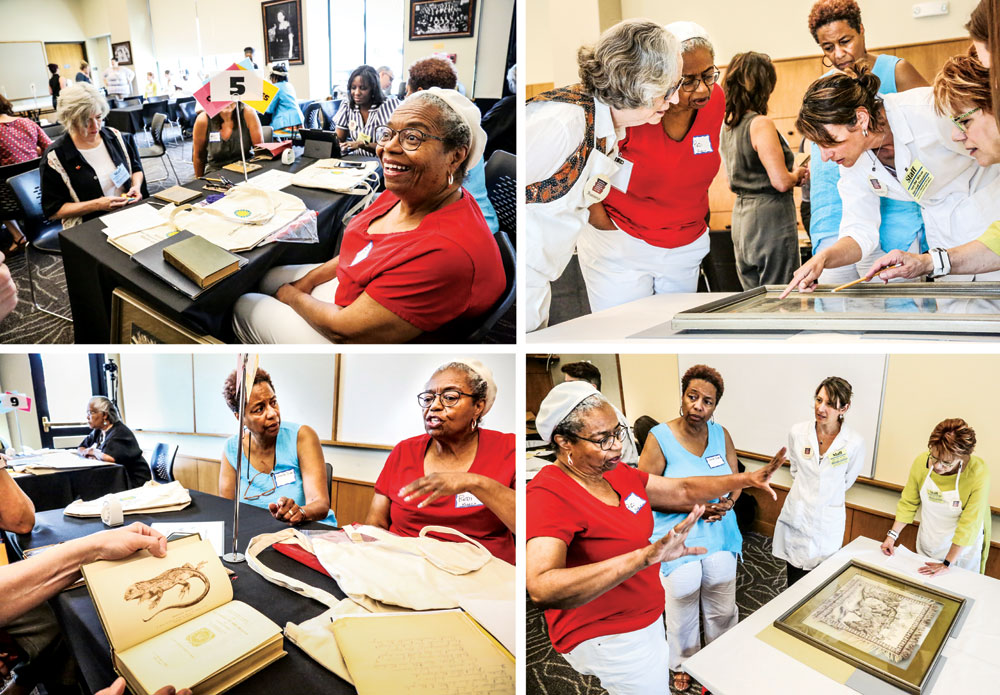
Rodella Wooten (wearing red) and her sister Leneta Jones (wearing blue), meet with experts from the Smithsonian Museums to learn historical information about their family heirlooms.
“I can only tell you what my mother told me,” Rodella Wooten said. She and her sister, Leneta Jones, brought several heirlooms passed down from their maternal grandfather, James David Knox. They believe he was most likely the son of a slave owner because of his light features and hazel-green eyes, though some of their lineage remains murky because, as Rodella put it, “Children don’t listen.” She and her sister are fairly certain they have at least some of their history correct. They believe their grandfather ran away from his slave-owning father’s plantation when he was quite young and became a traveling minister after he graduated from Shaw University in South Carolina. He also traveled to Africa and lived long enough to make an impact on Rodella’s life. “I haven’t had much trauma in my life,” she said, “But I was sad seeing him quiet and withdrawn in a retirement home. He wasn’t like that when I was little. I was a feely kid, and he let me climb on him; he didn’t mind.”
Among Knox’s treasures is a woven tapestry with fringed edges, hand-sewn to a board and featuring African—possibly Egyptian—figures holding a tiger on what appears to be a safari hunt (left). Wooten remembers her mother using the tapestries as furniture covers when she was a kid. “You know everyone had crocheted doilies back then,” she said. “But my mother had these. There were originally six of them, all with African images depicting different stories.” The reviewer dated the tapestry to the early 1900s, most likely before 1920. She also agreed with the sisters that they could have been souvenirs from Knox’s travels.
Their grandfather also left them beautiful hand-written letters, which he wrote to a newspaper advocating against the Marcus Garvey movement that suggested African Americans return to their homeland. It’s unclear whether they were ever published. Before they left, the sisters received advice on how to preserve their heirlooms.
100-Year-Old Photo of African American Airmen
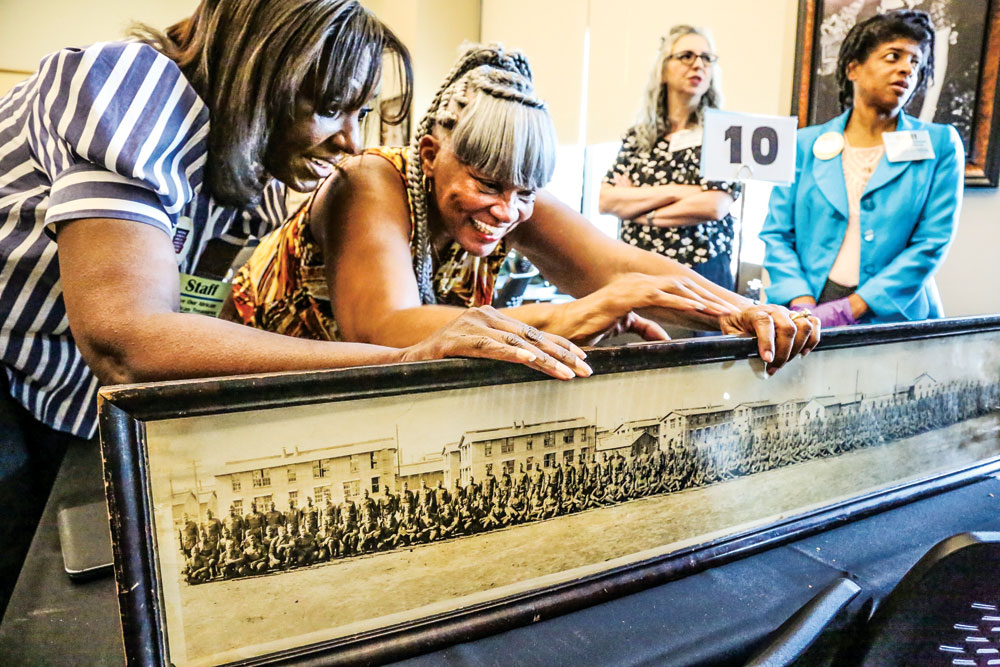
Pat Duncan (second from left) and Smithsonian curator Shannon Perich read information on the back of a 100-year-old photograph of 100 African American airmen.
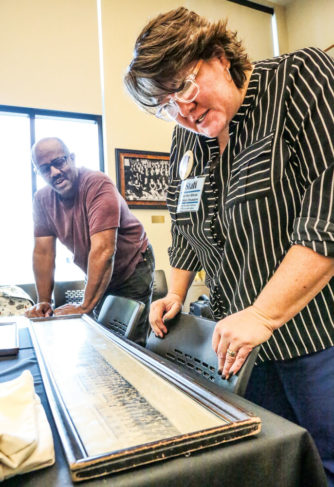
Pat’s husband, Kevin Duncan, looks on as a Smithsonian researcher examines the photo in which his great uncle is pictured.
Pat Duncan (above, second from left) is a local photographer and celebrated author, so the Hometown Treasures event was exactly her kind of thing. Her two books “A Defining Moment” and “Defining the Times,” which chronicle Barack Obama’s rise to the presidency, reside at the Smithsonian and the Library of Congress. However, like many, she wasn’t always so interested in preserving history. She can vividly remember her father-in-law, William T. Duncan, pointing out his uncle, Ivan Johnson, in a panoramic photograph of more than 100 African American airmen. But, she adds, “The young don’t always pay attention.” With her father-in-law suffering from dementia, she and her husband, Kevin Duncan (who have been married for 35 years), can no longer point out which of the young, sober faces belongs to Ivan. “It’s unfortunate,” she laments. The photograph, which is still in its original frame, is in good shape—and the couple was happy to learn tips for preserving their precious photo, which was captured over 100 years ago on February 17, 1919 at the Lackland Air Force Base in Monmouth, IL.



0 Comments